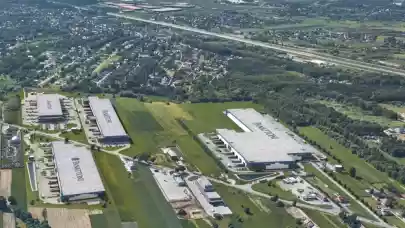
Reducing carbon emissions is surely becoming a top priority for landlords especially since numerous investors have committed to reaching net-zero emissions. At the same time, they’re also discovering that digital tools can help improve occupancy in office buildings which often stand half-empty these days due to widespread remote working. It’s high time for the industry to use disruptive technology and invest in digitization to improve utilization of space and reduce carbon emissions, says a new report on ESG and digitalization in the office market by workcloud24.
ESG at the top of the agenda in the industry
Out of the 51 gigatons of mankind produced pollution per year, real estate is responsible for approximately 39 % of total global emissions. To mitigate the effects of climate change, more and more investors are announcing net-zero commitments. Real estate developers and asset managers will need to follow if they do not want to risk their valuation and performance. According to PWC, ESG compliance is already number one in due diligence.
In fact, the pressure from capital markets, supported by public expectation, creates a transition risk for the industry as more than 90% of the commercial buildings do not meet ESG standards today.
According to McKinsey, without mitigating actions, climate risks could reduce annual returns toward the end of the decade by as much as 40 %. Other studies show that certified buildings can achieve significantly higher rents and report higher occupancy than non-certified buildings.
Tenants are demanding more sustainable buildings, as the awareness of their employees and stakeholders have risen. Soon, most corporate tenants will only sign up for buildings complying with ESG standards.
The role of digitization
Real estate owners and investors will need to improve their climate intelligence to understand the potential impact of revenue, operating costs, capital costs and capitalization rate on assets. This includes developing the analytical capabilities to consistently assess both physical and transition risks.
ESG is all about sufficient data points which are processed digitally. Hence, every ESG approach should start with digitization and a general check on the systems available to process data.
This exercise gets far easier for new projects where the team can simulate a digital twin from the start and hence knows exactly what the building consists of. Creating a digital twin of the building before the first stone is moved results in significant savings in costs, transport, material, time and energy which plays well into ESG compliance.
Gathering data and using technology to manage a building based on the data is trickier for older properties where significant investment is needed.
The cost of workplaces
Running an office building takes up to 350 kWh/sqm/GLA/year of operational energy and to build one sqm of GLA up to 3.500 kWh of embedded energy is required.
In countries like Poland, where 96 % of the energy comes from coal-fired power plants, this leads to 2.8 tons embedded carbon while additional 0,28 tons per sqm per year of carbon is emitted due to operation. With today’s standard of 10 sqm per workstation, this leads to 2.8 tons operational carbon due to operation every year and a massive 28 tons of embedded carbon per workstation.
“Therefore, it´s crucial how efficient we use space and how much energy is needed to operate it. So, on the one hand, it matters which technology for HVAC systems and lighting is built in, how it is monitored and on the other hand, it matters how the space is utilized,” explains Hubert Abt, CEO and Founder of New Work and workcloud24.

Hubert Abt
CEO
New Work & workcloud24
While on the operational side the problem can be overcome by using smart software which lowers the energy consumption during the time the office is not occupied, the problem with embedded carbon only can be solved by using as many CO2 neutral materials as possible when constructing or modernizing the building.
While on the operational carbon management side, there are plenty of software applications that support, measure and control energy, the available software on measuring and managing the embedded carbon are far less available.
To build the intelligence on the landlord side, it´s not only crucial to build awareness by changing the culture in the company, but also to find the digital tools to support this process.
Improving utilization
Knowing that sustainable, certified buildings achieve higher rents and occupancy should be reason enough to deep dive into the possibilities on how landlords can create added value for a single building or a portfolio aligned with ESG standards.
Studies show that by improving utilization, significant savings on carbon emissions can be achieved. To be able to improve utilization at a time when offices are half-empty most of the time due to remote working (which is here to stay), however, requires rethinking the way we use office space.
As with everything in ESG, this also starts with data points. We need to ensure that we measure the utilization of the space first. Measurement can happen by sensors that are installed on each workstation or by using space manager software.
By using space manager software, the floor plan gets digitized. All users have an application that allows them to book their workplace in advance, check-in and check-out when they leave.
The administrator can then issue a report on the average utilization grade of the space, the peak loading times and can manage the hybrid workforce accordingly, this increasing utilization.
“At New Work Offices, this is achieved by the “Space in the Cloud” concept where tenants can reduce their core space commitment down to 50% and cover the peak loading factor with cloud services,” adds Hubert Abt.
Impact on leasing activities
Increased utilization has a positive effect on leasing activities as the leasing team can make add value propositions to new tenants signing up for the core space and the fact that the product is fully digitized allows the marketing team a multi-level approach which is not in place with the common way of leasing office space.
Of course, this requires some additional investment from the landlord as space must be prepared for immediate use and daily operation, but at the same time, the landlord is able to achieve a premium on revenues with a management-based leasing approach.
Once digitized, landlords can use their locations to create multiple revenue streams and improve asset values or launch entirely new businesses.



